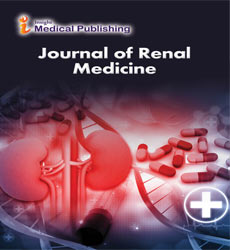Kidney Transplantation for Renal Failure Post-Lung Transplantation Outcomes and Renal Safety Considerations
Jawad Galle*
Department of Medicine, Medical University of Silesia in Katowice, Zabrze, Poland
- *Corresponding Author:
- Jawad Galle
Department of Medicine, Medical University of Silesia in Katowice, Zabrze,
Poland,
E-mail: galle-j@yahoo.com
Received date: June 21, 2024, Manuscript No. IPJRM-24-19521; Editor assigned date: June 25, 2024, PreQC No. IPJRM-24-19521 (PQ); Reviewed date: July 09, 2024, QC No. IPJRM-24-19521; Revised date: July 16, 2024, Manuscript No. IPJRM-24-19521 (R); Published date: July 23, 2024, DOI: 10.36648/ipjrm.7.4.39
Citation: Galle J (2024) Kidney Transplantation for Renal Failure Post-Lung Transplantation Outcomes and Renal Safety Considerations. J Ren Vol.7 No.4: 39.
Description
Constant renal disappointment is quite possibly of the most well-known complexity after strong organ transplantation. Various pre and post relocate factors are connected to it. In some cases, conservative treatment options are insufficient, necessitating Kidney Transplantation (KTx). The point of this study was to introduce our involvement with the treatment of renal disappointment by KTx after Lung Transplantation (LTx). Renal security is a vital viewpoint among LTx beneficiaries hence, doctors should show a comprehensive and individual way to deal with patients and limit openness to nephrotoxic medicine. KTx and other forms of renal replacement therapy, if necessary, should be started in patients at high risk for chronic renal failure.
End-Stage Renal Disease (ESRD)
The populace maturing the quantity of patients with Chronic Kidney Disease (CKD) has been step by step expanding. Multiple organs are affected when CKD progresses to End-Stage Renal Disease (ESRD), which is now a serious global health issue. Additionally, studies have recommended that the gamble of abrupt sensorineural hearing misfortune is 2.71 times higher in those with kidney illness than those without. In addition, other studies have demonstrated that CKD patients have a higher prevalence of HL than the general population and a higher risk of HL as renal function deteriorates. Hearing brokenness in patients with CKD is related with various variables. Likewise, concentrates on proposed that SNHL in CKD patients is bound to be brought about by cochlear brokenness. Also, a few investigations showed that kidney capability recuperation, HL can be lightened or even completely restored. Which is basically blended and discharged by osteocytes and osteoblasts and appropriated in bone marrow, thymus, lymph hubs and paraventricular core. CKD, calcium and phosphate metabolism disorders, hyperparathyroidism, ventricular hypertrophy, cardiac valve calcification, anemia, cognitive impairment, insulin resistance and other diseases are all linked to high levels of FGF23, according to studies. Additionally, our previous research demonstrated that ESRD patients with HL had significantly elevated serum FGF23 levels and a prevalence of HL of as high as 80.5%. In this review, we further surveyed the relationship among FGF23 and hearing in CRF patients and rodents with renal disappointment. Onychomycosis is perhaps of the most widely recognized cutaneous side effect in patients with constant renal disappointment.
Onychomycosis
Onychomycosis is a common contagious contamination of the toenails and fingernails brought about by a different cluster of organisms. Dermatophytes, yeasts and Non-Dermatophyte Molds (NDMs) are this disease's most normal causative specialists. Onychomycosis is more normal in Helps patients, as per late examinations. On top of that, people with Chronic Kidney Disease (CKD) are thought to be at a higher risk of developing onychomycosis. Cutaneous appearances are seen in essentially all patients with moderate kidney disappointment. These signs can be ascribed to uremia, metabolic issues, dialysis and medication secondary effects. In kidney failure, cutaneous manifestations can take many forms and range widely. According to the literature, onychomycosis occurs more frequently in hemodialysis patients than in healthy individuals, with a prevalence ranging from 19%-51.9%. The most well-known growths segregated from patients in that study were dermatophytes, spp and non-dermatophyte molds. Additionally, the study found that diabetics were 88% more likely to develop onychomycosis than non-diabetic individuals and that the risk of developing onychomycosis increased by 1.9% with each additional year of age. The pervasiveness of onychomycosis may likewise change across locales, with individual dietary propensities, living climate, environment, financial and healthful status and racial contrasts. There is still a dearth of information regarding the prevalence of this infection in particular populations, such as Iranian patients, despite the growing body of research on onychomycosis in patients on dialysis and the rising incidence of onychomycosis in chronic renal failure. The point of the current review was to research the commonness of onychomycosis among dialysis patients and decide the elements liable to be related with its turn of events.
Open Access Journals
- Aquaculture & Veterinary Science
- Chemistry & Chemical Sciences
- Clinical Sciences
- Engineering
- General Science
- Genetics & Molecular Biology
- Health Care & Nursing
- Immunology & Microbiology
- Materials Science
- Mathematics & Physics
- Medical Sciences
- Neurology & Psychiatry
- Oncology & Cancer Science
- Pharmaceutical Sciences
